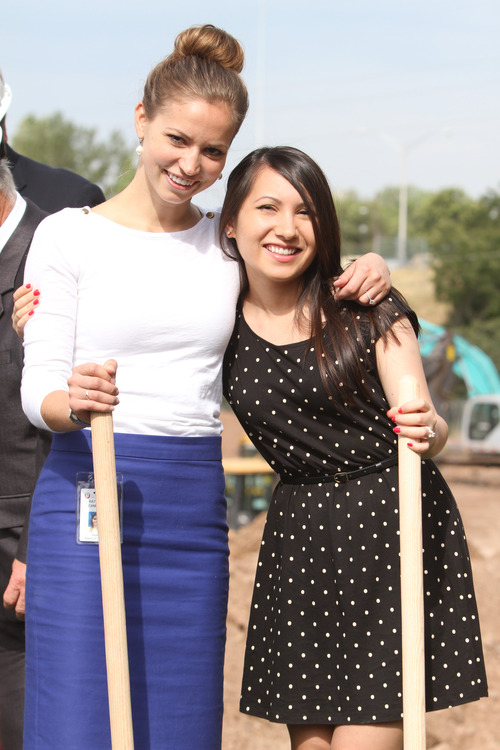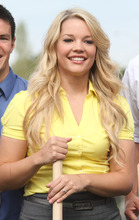This is an archived article that was published on sltrib.com in 2013, and information in the article may be outdated. It is provided only for personal research purposes and may not be reprinted.
Rachel Smith has wanted to go to dental school since her childhood dentist treated her "filleted" face after she fell onto a ledge while racing a friend at age 12.
''It's more than just filling cavities," the 24-year-old said, "it can be healing as well."
She was one of 20 people chosen from a pool of about 850 applicants for the inaugural class at the new School of Dentistry at the University of Utah, a group whose 3.8 GPA is the highest of any entering dental class in the country, administrators say. Earlier this month, she took her husband to a ceremony where she received her official white dentist's coat.
She also got something of a surprise.
"Everyone thought he was the dental student," she said.
And classmate Kathryn Cameron said people tried to dissuade her from the profession.
"A lot of people told me not to go for it," said Cameron, 25, "basically saying, 'Your role as a woman is to stay home with the kids.' "
When they finish their degrees, Cameron and Smith will join an unusually small group. Less than 3 percent of the state's dentists are women, according to a 2009 American Dental Association report, making Utah the state with the country's lowest percentage of female practitioners.
It isn't the only gender differential in Utah. Women here lag further behind men than the national average in science, technology, engineering and math fields, collectively known as STEM, according to the Utah Women and Education Initiative.
But while the 21 percent of doctors who are women is nearly equivalent to the rest of the country, a 2012 state report found the number of female dentists is puzzlingly low.
"I don't really have a good idea why, exactly," said Utah State Dental Director Kim Michelson.
Dentistry is a popular profession in Utah: The state has the 19th-highest number of dentists per capita in the country, according to the ADA, and about 2,000 hopefuls applied for 80 seats when the private nonprofit Roseman University opened a dental school two years ago.
The profession, however, is also less racially and ethnically diverse than the state. For example, a 2006 state report found that while Latino residents made up about 11 percent of Utah's population, they were less than 1 percent of the state's dentists.
But with a national average income of more than $192,000 a year for an independent practitioner and almost $306,000 for a specialist, according to the ADA, the field can offer a healthy paycheck as well as a chance to give back.
"A lot of young dentists want to serve their communities," said Michelson. "And it's just an attractive career choice."
They may not be in the dentist's chair, but there are women in Utah treating teeth. "Almost all the dental assistants in Utah are women," he said.
Dental assistants, who often act as a second pair of hands for dentists working on patients, don't need a lengthy education or professional license in Utah, but still make a national average of $18 an hour, the ADA reports. There also are more women among the ranks of dental hygienists, who earn a degree and can perform cleanings and examine gums.
Becoming a dentist, meanwhile, requires four years of dental school and more to become a specialist. That's what periodontist LaRisse Skene did.
"I think it's just a long road. That's probably the most intimidating thing about it," she said.
And after school, most dentists start their own practices, which requires an upfront investment of up to $500,000 in X-ray machines, drills, chairs and other equipment, another potential hurdle.
But her training has given Skene a career with the flexibility to take time off with her now-3-month-old daughter and the chance to fulfill her passions for art and working with her hands.
"Honestly, it's so great for being a mom," she said. "I can work four days a week and I'm still able to provide for our family ... and not feel like I'm punching the clock."
Young girls, though, might not see the artistry of what Skene does in dental work, and educators could do more to get them interested in the profession, said Lea Erickson, director of public health and professional practice at Roseman.
"The key is really starting the pipeline early," said Erickson, an associate professor who encountered her own detractors in dental school in Maryland in the 1970s. "We don't go in and talk to people in high school about it."
The new dean of the U.'s dental school is one of the country's few women in the position.
Rena D'Souza has been recognized for her work with tooth stem cells that could someday end the need for root canals by re-growing the living tissue known as tooth pulp.
"We are going to work and strive to increase those [female dentist] numbers," D'Souza said at the groundbreaking for the school's new $36.4 million building.
There are some signs of growth. More young Utah dentists are women, though the 4.6 percent of those who began practicing in the past 10 years is still far lower than the national average.
The four women in the school's inaugural class make up about 20 percent of the total — higher than previous classes at the U.'s Regional Dental Education Program the new school is replacing and about equal to the portion of working female dentists in the rest of the country. Classmate David Clark, 27, said he's happy to have them.
"I was excited to see so many female students in the class," he said. "I think they'll bring a new perspective to dentistry. ... It's good for everyone to have more diversity."
Twitter: @lwhitehurst









